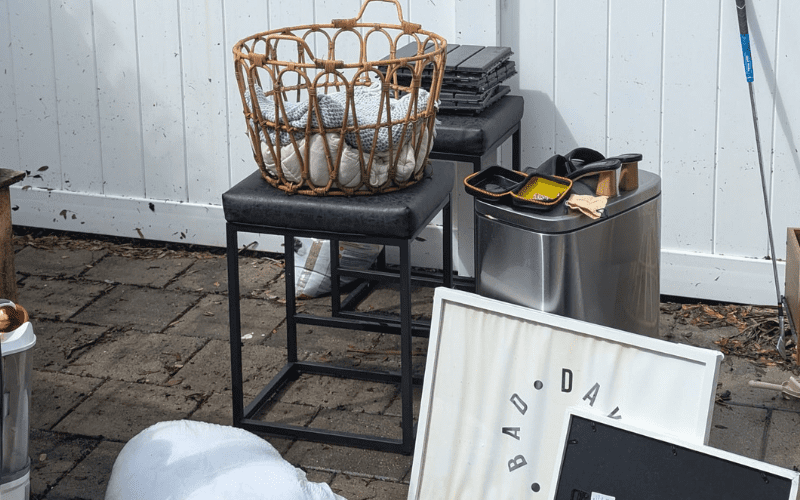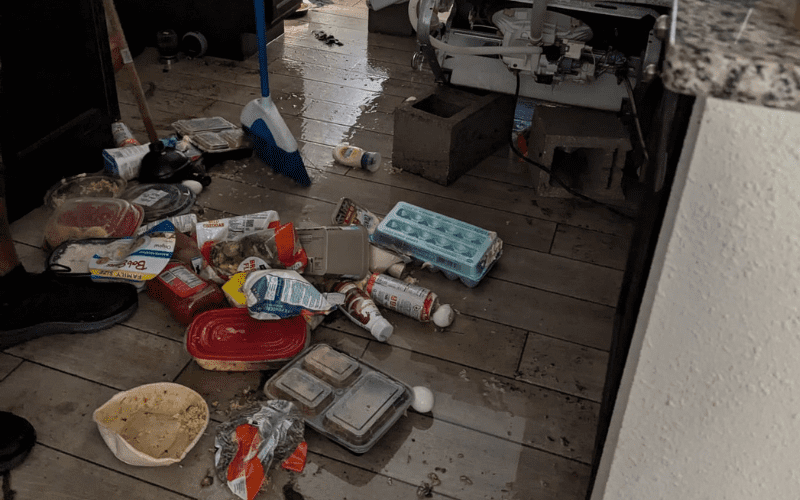Never mix bleach with ammonia or other cleaners—it creates toxic fumes.
Flooding in Tampa Bay is no small issue. Whether caused by hurricanes, storm surges, or improper drainage, flood damage can leave behind hazardous conditions, mold risk, and serious property damage. Knowing how to clean up after a flood and when to call a professional flood cleanup company in Tampa Bay is key to protecting your home or property and preventing long-term damage.

Backyard patio with unwanted items and furniture staged for a residential junk removal service in Tampa Bay by Site Masters.
If you’re staring at soaked floors, damaged drywall, and debris all around your yard, here’s a step-by-step guide to flood cleanup, safety precautions, and when to bring in the pros.
Before you touch anything, confirm that the main power to your home or building is turned off. Floodwater can get into outlets, junction boxes, and appliances, creating major electrical hazards.
Also inspect the building’s structural stability. Flooding can weaken flooring, walls, and foundations, especially in older homes, homes with termite damage, or structures with poor drainage.
Floodwater isn’t just water — it’s often contaminated with sewage, chemicals, and bacteria. Even rainwater floods can pick up hazardous materials from roads, yards, and nearby buildings.
Wear protective gear like gloves, boots, and masks. Never touch floodwater with bare skin, especially with any open wounds due to the high heat in Florida risks of bacteria are more prevalent. In Tampa Bay, flood cleanup should always start with containment, disinfection, waste removal, and moisture remediation before any rebuilding begins.
Once it’s safe to enter the property, the first step is removing anything that has absorbed water. Soaked furniture, mattresses, and carpeting hold moisture, making them a breeding ground for mold and bacteria. These items should be taken out quickly before they spread contamination to other parts of the home.
Next, clear out all trash, debris, and yard waste that may have been carried in by the water. Floods often bring mud, branches, and other debris that create unsafe and unsanitary conditions.
Damaged appliances and electronics should also be hauled away, as they are both hazardous and costly to keep on site. Leaving them in place not only increases health risks but also delays repairs and restoration.
Speed is critical every hour matters after water damage. The longer wet materials sit, the greater the risk of structural damage, mold growth, and harmful bacteria. Items that cannot be thoroughly disinfected should be removed entirely to protect your health and property value.
At Site Masters, our junk and debris removal services in Tampa Bay are equipped to handle flood-damaged items, yard waste, broken appliances, furniture, and more. We provide full-service hauling to restore safety, curb appeal, and peace of mind after a disaster

Our professional team handles challenging property cleanup, including hoarder cleanout and flood cleanup in Tampa Bay. We safely remove all trash, debris, and junk to restore the property.
Even after water is removed, flood-contaminated surfaces remain unsafe. Floodwaters often contain bacteria, sewage, chemicals, and mold spores that can linger long after the property appears dry. Proper disinfection is critical for health and safety.
Start with hard, non-porous surfaces such as tile, metal, plastic, and sealed concrete. These can be disinfected with an EPA-registered antimicrobial cleaner, hydrogen-peroxide–based disinfectant, or (when appropriate) a diluted bleach solution (1 cup bleach to 1 gallon of water). Allow at least 10 minutes of contact time before rinsing, and ensure good ventilation.
For porous materials like drywall and insulation, disinfection is not recommended. If these get wet, they cannot be reliably cleaned and will need to be cut out during the step 6. Attempting to wash drywall only leaves moisture trapped inside, which accelerates mold growth.
On exposed framing, studs, and subfloors that remain after flood cuts, apply a mold-resistant antimicrobial spray or primer to kill any lingering spores and protect against regrowth.
Never mix bleach with ammonia or other cleaners—it creates toxic fumes.
Always wear gloves, eye protection, and a respirator if using strong disinfectants.
Once debris is removed, it’s essential to begin the drying process immediately to prevent mold and structural damage. Use commercial-grade fans and dehumidifiers to extract moisture from the air and building materials. This step is critical because mold can begin growing within 24–48 hours of water exposure, according to the U.S. Environmental Protection Agency (EPA).
If outdoor humidity is lower than indoor levels, keep windows open to improve airflow and accelerate drying. Continue to monitor hidden and hard-to-reach areas, such as attics, crawl spaces, basements, and wall interiors, for lingering dampness. The Federal Emergency Management Agency (FEMA) also stresses the importance of checking these areas regularly after flooding to avoid hidden mold growth.
We strongly recommend scheduling a professional flood damage inspection in Tampa Bay to verify moisture levels with specialized equipment before moving forward with repairs. The Centers for Disease Control and Prevention (CDC) provides guidelines on safe cleanup and moisture control that reinforce the need for expert evaluation.
By combining proper cleanup, thorough drying, and professional inspection, you protect your property’s structure, ensure a safe environment, and reduce the risk of long-term health issues.
If the flood reached inside your walls or soaked your baseboards you’ll likely need a flood cut or drywall demolition — this means removing the bottom section of drywall (typically 12 to 24 inches above the waterline) to:
If drywall stays wet for more than 24-48 hours, mold can grow (especially without AC) and mold removal in Tampa Bay can be far more costly than proactive cleanup.
When you’re ready to rebuild, choose materials that reduce future flood risks, like:
We’ve helped dozens of residential and commercial property owners recover from hurricane flooding, pipe bursts, and stormwater damage. Here’s what sets us apart:
Full-service flood debris removal, junk hauling, and broken appliance removal.
Experience in drywall flood cuts to begin the next steps right away so your property can start drying out.
Photo documentation for insurance or ownership reports.
Local pricing with no hidden fees.
You should begin the cleanup process within 24 to 48 hours. Quick action is the best way to prevent mold growth, which can start very quickly in Florida’s humid climate and lead to more extensive and costly repairs.
For very small, clean-water incidents, DIY cleanup may be possible. However, for significant flooding involving contaminated water or saturated structural materials, we strongly recommend hiring a professional flood cleanup company in Tampa Bay. Professionals have the proper safety gear and industrial-grade equipment to ensure the property is completely dry and disinfected.
The biggest risk after a flood in the Tampa area is mold growth. The combination of heat and high humidity creates the perfect environment for mold to thrive in damp, dark spaces like wall cavities and under flooring, posing serious health risks and causing structural damage.
Let’s walk the property together and create a cleanup plan that protects your site and reduces long-term damage.
Learn More About Our Junk Removal ServicesTampa Bay’s trusted partner in
complete property cleanup
Call Now For a Free Service Quote
© 2025 All Rights Reserved. The Site Masters | Privacy Policy | Terms & Conditions